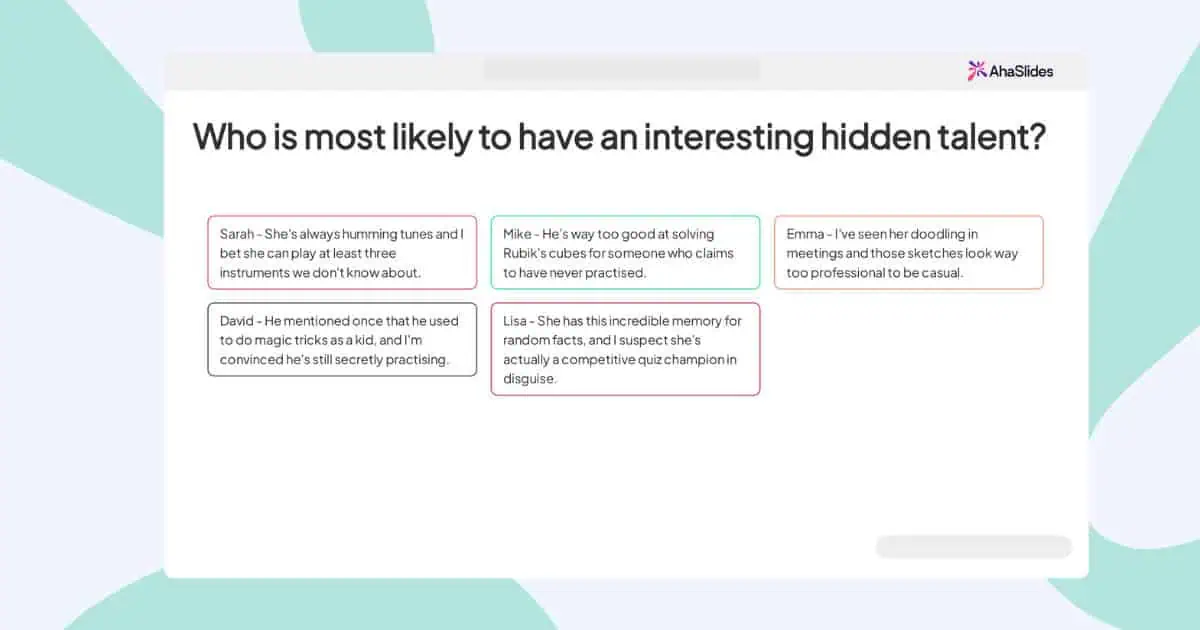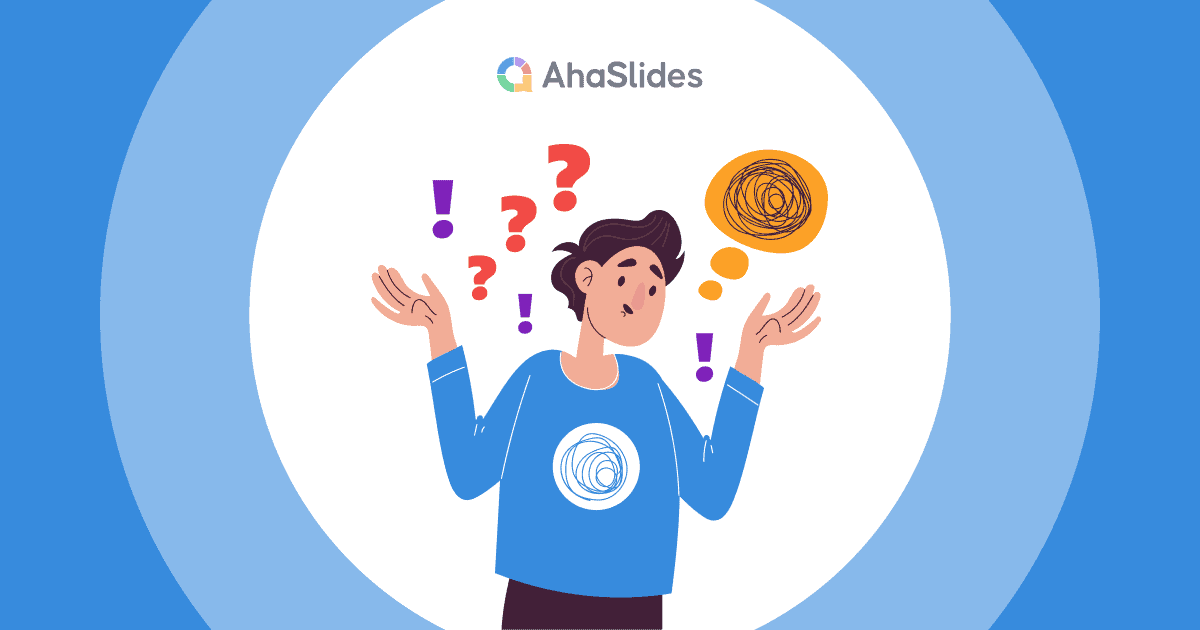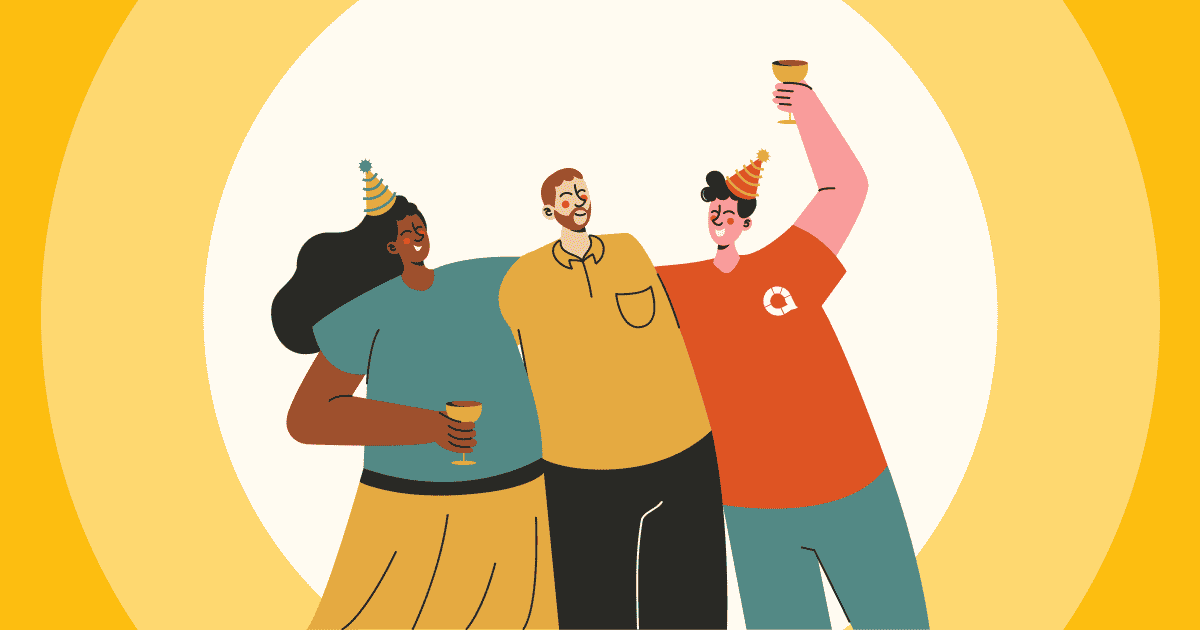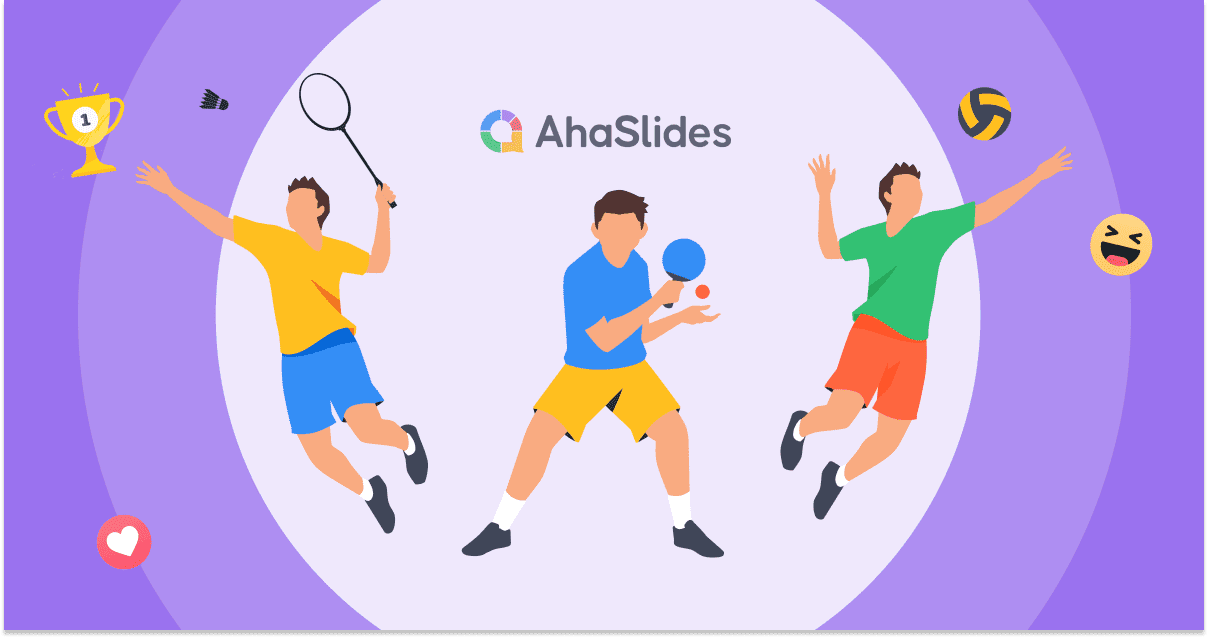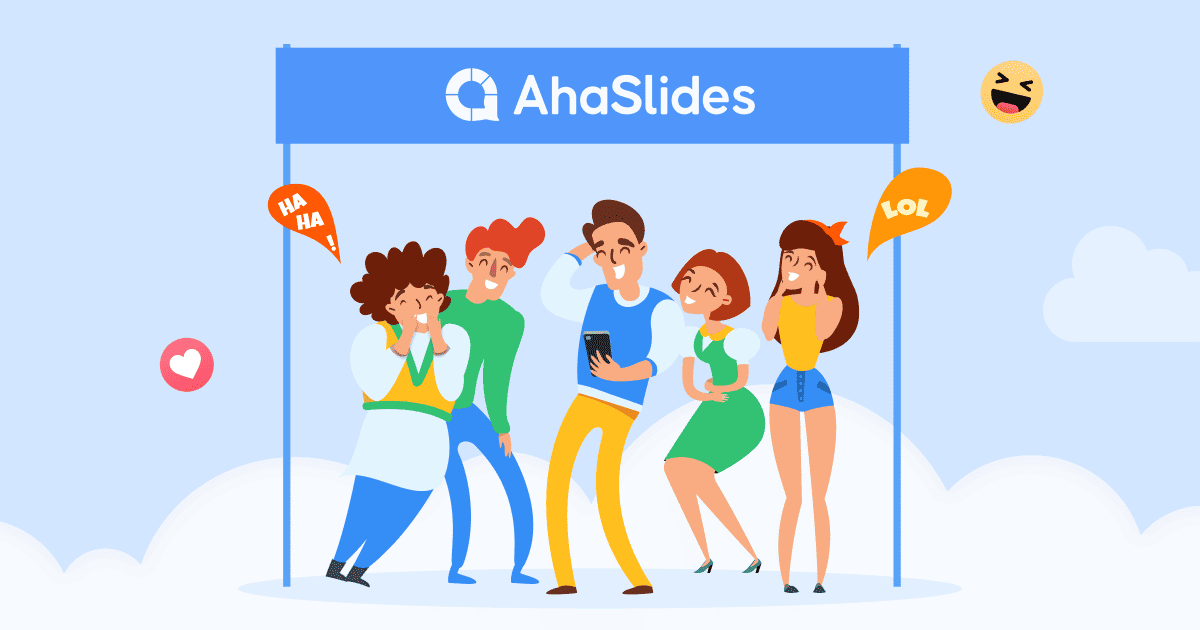When training sessions start with awkward silence or participants seem disengaged before you've even begun, you need a reliable way to break the ice and energise your audience. "Most likely to" questions offer trainers, facilitators, and HR professionals a proven method for creating psychological safety, encouraging participation, and building rapport amongst participants—whether you're running onboarding sessions, team development workshops, or all-hands meetings.
This guide provides 120+ carefully curated "most likely to" questions designed specifically for professional contexts, along with evidence-based facilitation strategies to help you maximise engagement and create lasting connections within your teams.
- Why "Most Likely To" Questions Work in Professional Settings
- How to Facilitate "Most Likely To" Questions Effectively
- 120+ Professional "Most Likely To" Questions
- Beyond the Questions: Maximising Learning and Connection
- Creating Interactive "Most Likely To" Sessions with AhaSlides
- The Science Behind Effective Icebreakers
- Small Activities, Significant Impact
Why "Most Likely To" Questions Work in Professional Settings
The effectiveness of "most likely to" questions isn't just anecdotal. Research into team dynamics and psychological safety provides solid evidence for why this simple icebreaker delivers measurable results.
Building psychological safety through shared vulnerability
Google's Project Aristotle, which analysed hundreds of teams to identify success factors, found that psychological safety—the belief that you won't be punished or humiliated for speaking up—was the most important factor in high-performing teams. "Most likely to" questions create this safety by encouraging playful vulnerability in a low-stakes environment. When team members laugh together about who's "most likely to bring homemade biscuits" or "most likely to win at pub quiz night," they're actually building the trust foundations needed for more serious collaboration.
Activating multiple engagement pathways
Unlike passive introductions where participants simply state their names and roles, "most likely to" questions require active decision-making, social reading, and group consensus. This multi-sensory engagement activates what neuroscientists call "social cognition networks"—the brain regions responsible for understanding others' thoughts, intentions, and characteristics. When participants must evaluate their colleagues against specific scenarios, they're forced to pay attention, make judgements, and interact, creating genuine neural engagement rather than passive listening.
Revealing personality in professional contexts
Traditional professional introductions rarely reveal personality. Knowing someone works in accounts receivable tells you nothing about whether they're adventurous, detail-oriented, or spontaneous. "Most likely to" questions surface these traits naturally, helping team members understand each other beyond job titles and org charts. This personality insight improves collaboration by helping people anticipate working styles, communication preferences, and potential complementary strengths.
Creating memorable shared experiences
The unexpected revelations and moments of laughter generated during "most likely to" activities create what psychologists call "shared emotional experiences." These moments become reference points that strengthen group identity and cohesion. Teams who laugh together during an icebreaker develop inside jokes and shared memories that extend beyond the activity itself, creating ongoing connection touchpoints.

How to Facilitate "Most Likely To" Questions Effectively
The difference between an awkward, time-wasting icebreaker and an engaging team-building experience often comes down to facilitation quality. Here's how professional trainers can maximise the impact of "most likely to" questions.
Setting Up for Success
Frame the activity professionally
Start by explaining the purpose: "We're going to spend 10 minutes on an activity designed to help us see each other as complete people, not just job titles. This matters because teams that know each other personally collaborate more effectively and communicate more openly."
This framing signals that the activity has a legitimate business purpose, reducing resistance from sceptical participants who view icebreakers as frivolous.
Running the Activity
Use technology to streamline voting
Rather than cumbersome hand-raising or verbal nominations, use interactive presentation tools to make voting instant and visible. AhaSlides' live polling feature allows participants to submit their votes via mobile devices, with results appearing in real-time on screen. This approach:
- Eliminates awkward pointing or calling out names
- Shows results immediately for discussion
- Enables anonymous voting when needed
- Creates visual engagement through dynamic graphics
- Works seamlessly for both in-person and virtual participants
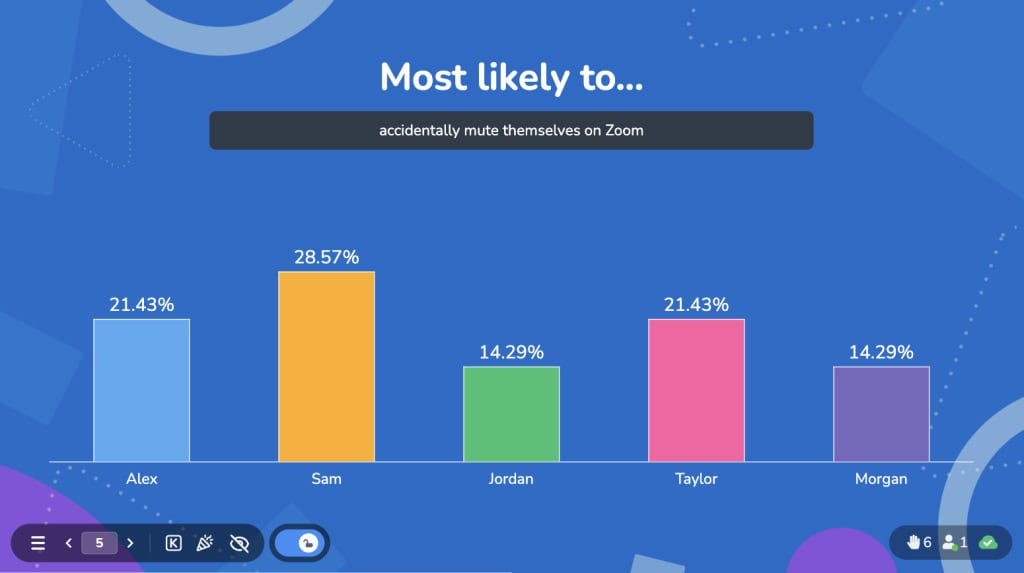
Encourage brief storytelling
When someone receives votes, invite them to respond if they wish: "Sarah, looks like you won 'most likely to start a side business.' Want to tell us why people might think that?" These micro-stories add richness without derailing the activity.
120+ Professional "Most Likely To" Questions
Icebreakers for New Teams and Onboarding
These questions help new team members learn about each other without requiring deep personal disclosure. Perfect for the first few weeks of team formation or new employee onboarding.
- Who is most likely to have an interesting hidden talent?
- Who is most likely to know the answer to a random trivia question?
- Who is most likely to remember everyone's birthdays?
- Who is most likely to suggest a team coffee run?
- Who is most likely to organise a team social event?
- Who is most likely to have visited the most countries?
- Who is most likely to speak multiple languages?
- Who is most likely to have the longest commute to work?
- Who is most likely to be the first person in the office each morning?
- Who is most likely to bring homemade treats for the team?
- Who is most likely to have an unusual hobby?
- Who is most likely to win at a board game night?
- Who is most likely to know the lyrics to every 80s song?
- Who is most likely to survive longest on a desert island?
- Who is most likely to become famous one day?
Team Dynamics and Working Styles
These questions surface information about work preferences and collaboration styles, helping teams understand how to work together more effectively.
- Who is most likely to volunteer for a challenging project?
- Who is most likely to spot a small error in a document?
- Who is most likely to stay late to help a colleague?
- Who is most likely to come up with a creative solution?
- Who is most likely to ask the difficult question everyone's thinking?
- Who is most likely to keep the team organised?
- Who is most likely to research something thoroughly before deciding?
- Who is most likely to push for innovation?
- Who is most likely to keep everyone on schedule in meetings?
- Who is most likely to remember action items from last week's meeting?
- Who is most likely to mediate a disagreement?
- Who is most likely to prototype something new without being asked?
- Who is most likely to challenge the status quo?
- Who is most likely to create a detailed project plan?
- Who is most likely to spot opportunities others miss?
Leadership and Professional Growth
These questions identify leadership qualities and career aspirations, useful for succession planning, mentorship matching, and understanding team members' professional goals.
- Who is most likely to become a CEO one day?
- Who is most likely to start their own business?
- Who is most likely to mentor junior team members?
- Who is most likely to lead a major organisational change?
- Who is most likely to win an industry award?
- Who is most likely to speak at a conference?
- Who is most likely to write a book about their expertise?
- Who is most likely to take on a stretch assignment?
- Who is most likely to revolutionise our industry?
- Who is most likely to become the go-to expert in their field?
- Who is most likely to change careers completely?
- Who is most likely to inspire others to reach their goals?
- Who is most likely to build the strongest professional network?
- Who is most likely to advocate for diversity and inclusion initiatives?
- Who is most likely to launch an internal innovation project?
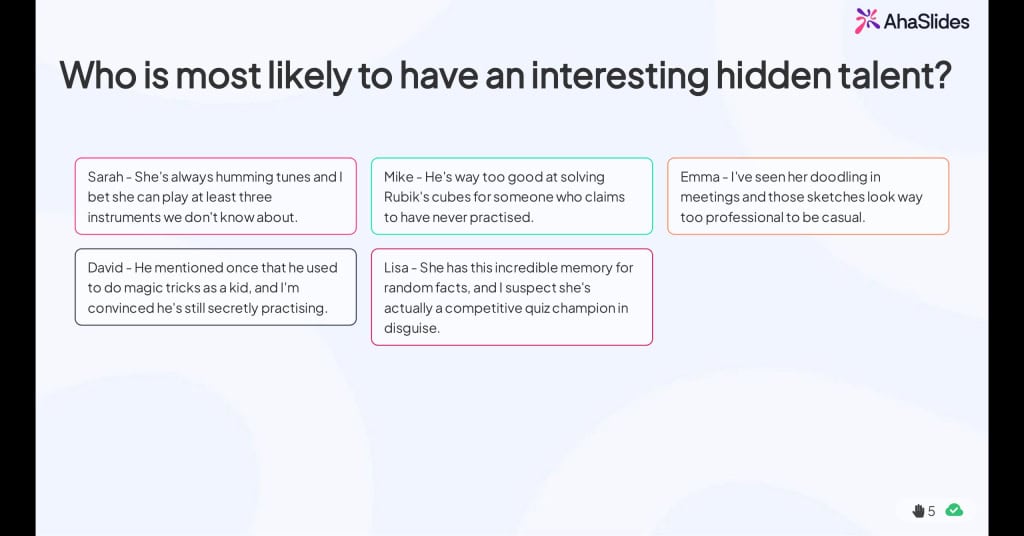
Communication and Collaboration
These questions highlight communication styles and collaborative strengths, helping teams understand how different members contribute to group dynamics.
- Who is most likely to send the most thoughtful email?
- Who is most likely to share a useful article with the team?
- Who is most likely to give constructive feedback?
- Who is most likely to lighten the mood during stressful times?
- Who is most likely to remember what everyone said in a meeting?
- Who is most likely to facilitate a productive brainstorming session?
- Who is most likely to bridge communication gaps between departments?
- Who is most likely to write clear, concise documentation?
- Who is most likely to check in on a struggling colleague?
- Who is most likely to celebrate team wins?
- Who is most likely to have the best presentation skills?
- Who is most likely to turn a conflict into a productive conversation?
- Who is most likely to make everyone feel included?
- Who is most likely to translate complex ideas into simple terms?
- Who is most likely to bring energy to a tired meeting?
Problem-Solving and Innovation
These questions identify creative thinkers and practical problem-solvers, useful for assembling project teams with complementary skills.
- Who is most likely to solve a technical crisis?
- Who is most likely to think of a solution no one else considered?
- Who is most likely to turn a constraint into an opportunity?
- Who is most likely to prototype an idea over the weekend?
- Who is most likely to debug the most difficult problem?
- Who is most likely to spot the root cause of an issue?
- Who is most likely to suggest a completely different approach?
- Who is most likely to build something useful from scratch?
- Who is most likely to find a workaround when systems fail?
- Who is most likely to question assumptions that everyone else accepts?
- Who is most likely to conduct research to inform a decision?
- Who is most likely to connect seemingly unrelated ideas?
- Who is most likely to simplify an overcomplicated process?
- Who is most likely to test multiple solutions before committing?
- Who is most likely to create a proof of concept overnight?
Work-Life Balance and Wellbeing
These questions acknowledge the whole person beyond their professional role, building empathy and understanding around work-life integration.
- Who is most likely to take a proper lunch break away from their desk?
- Who is most likely to encourage the team to prioritise wellbeing?
- Who is most likely to go for a walk during the workday?
- Who is most likely to have the best work-life boundaries?
- Who is most likely to disconnect completely on holiday?
- Who is most likely to suggest a team wellness activity?
- Who is most likely to decline a meeting that could be an email?
- Who is most likely to remind others to take breaks?
- Who is most likely to leave work exactly on time?
- Who is most likely to maintain calm during a crisis?
- Who is most likely to share stress management tips?
- Who is most likely to suggest flexible working arrangements?
- Who is most likely to prioritise sleep over late-night work?
- Who is most likely to encourage the team to celebrate small wins?
- Who is most likely to check in on team morale?
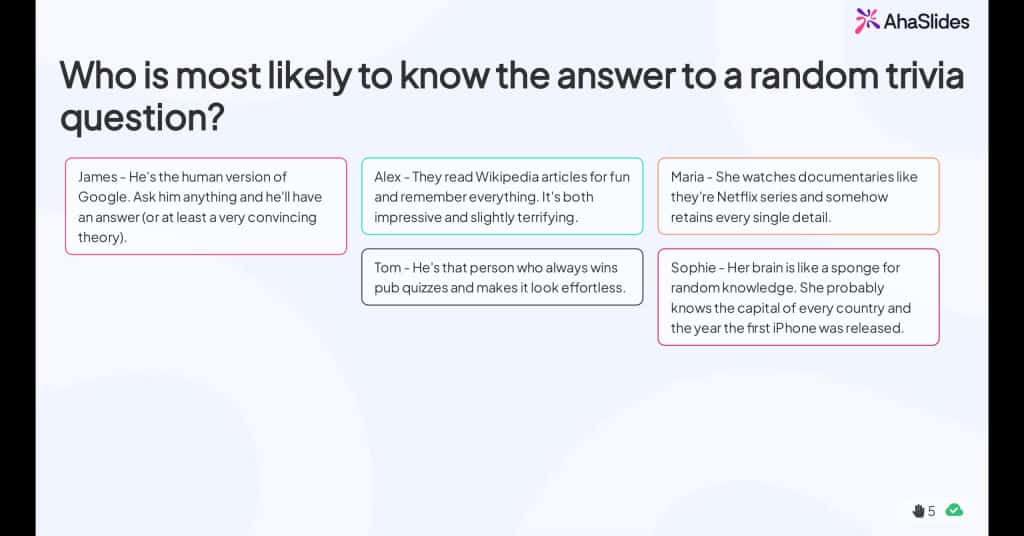
Remote and Hybrid Work Scenarios
These questions are specifically designed for distributed teams, addressing the unique dynamics of remote and hybrid working environments.
- Who is most likely to have the best video background?
- Who is most likely to be perfectly punctual for virtual meetings?
- Who is most likely to have technical difficulties on a call?
- Who is most likely to forget to unmute themselves?
- Who is most likely to stay on camera all day?
- Who is most likely to send the most GIFs in team chat?
- Who is most likely to work from a different country?
- Who is most likely to have the most productive home office setup?
- Who is most likely to join a call whilst walking outside?
- Who is most likely to have a pet make an appearance on camera?
- Who is most likely to send messages outside typical working hours?
- Who is most likely to create the best virtual team event?
- Who is most likely to have the fastest internet connection?
- Who is most likely to use the most productivity apps?
- Who is most likely to maintain the strongest remote team culture?
Light-Hearted Professional Questions
These questions add humour whilst remaining workplace-appropriate, perfect for building camaraderie without crossing professional boundaries.
- Who is most likely to win the office fantasy football league?
- Who is most likely to know where the best coffee shop is?
- Who is most likely to plan the best team outing?
- Who is most likely to win at table tennis during lunch?
- Who is most likely to organise a sweepstake?
- Who is most likely to remember everyone's coffee order?
- Who is most likely to have the tidiest desk?
- Who is most likely to correctly guess the number of jellybeans in a jar?
- Who is most likely to win a chilli cook-off?
- Who is most likely to know all the office gossip (but never spread it)?
- Who is most likely to bring the best snacks to share?
- Who is most likely to decorate their workspace for every holiday?
- Who is most likely to create the best playlist for focused work?
- Who is most likely to win a company talent show?
- Who is most likely to organise a surprise celebration?
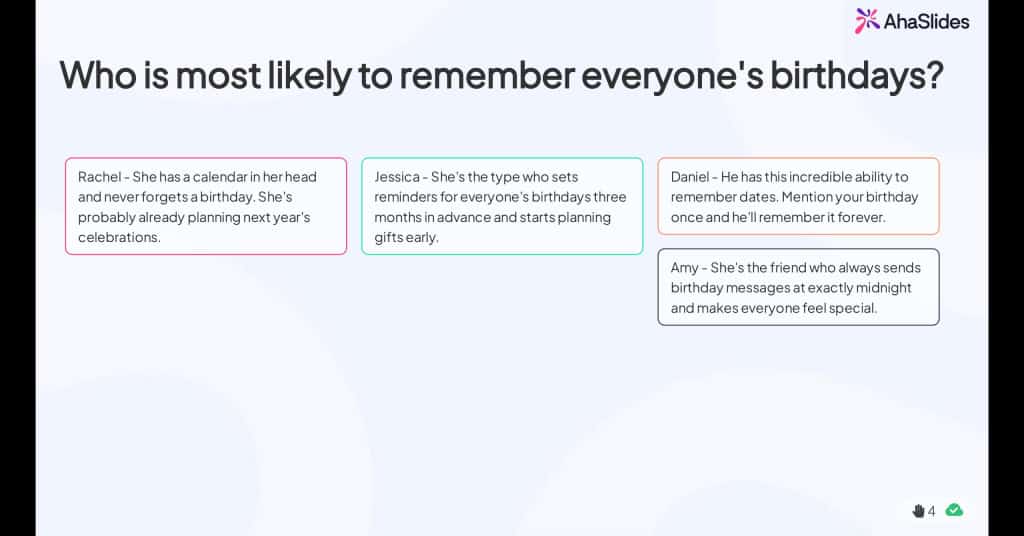
Beyond the Questions: Maximising Learning and Connection
The questions themselves are just the beginning. Professional facilitators use "most likely to" activities as springboards for deeper team development.
Debriefing for Deeper Insight
After the activity, spend 3-5 minutes debriefing:
Reflection questions:
- "What surprised you about the results?"
- "Did you learn anything new about your colleagues?"
- "How might understanding these differences help us work together better?"
- "What patterns did you notice in how votes were distributed?"
This reflection transforms a fun activity into genuine learning about team dynamics and individual strengths.
Connecting to Team Goals
Link insights from the activity to your team's objectives:
- "We noticed several people are creative problem-solvers—let's make sure we're giving them space to innovate"
- "The group identified strong organisers—perhaps we can leverage that strength for our upcoming project"
- "We have diverse working styles represented here, which is a strength when we learn to coordinate effectively"
Following Up Over Time
Reference insights from the activity in future contexts:
- "Remember when we all agreed Emma would spot errors? Let's have her review this before it goes out"
- "James was identified as our crisis solver—shall we involve him in troubleshooting this issue?"
- "The team voted Rachel as most likely to bridge communication gaps—she might be perfect to liaise between departments on this"
These callbacks reinforce that the activity provided genuine insight, not just entertainment.
Creating Interactive "Most Likely To" Sessions with AhaSlides
Whilst "most likely to" questions can be facilitated with simple hand-raising, using interactive presentation technology transforms the experience from passive to actively engaging.
Multiple-choice polling for instant results
Display each question on screen and allow participants to submit votes via their mobile devices. Results appear in real-time as a visual bar chart or leaderboard, creating immediate feedback and sparking discussion. This approach works equally well for in-person, virtual, and hybrid meetings.
Word cloud and Open-ended polls for open-ended questions
Rather than predetermined names, use word cloud features to let participants submit any response. When you ask "Who is most likely to [scenario]," responses appear as a dynamic word cloud where frequent answers grow larger. This technique reveals consensus whilst encouraging creative thinking.
Anonymous voting when needed
For questions that might feel sensitive or when you want to eliminate social pressure, enable anonymous voting. Participants can submit genuine opinions without fear of judgment, often revealing more authentic team dynamics.
Saving results for later discussion
Export voting data to identify patterns, preferences, and team strengths. These insights can inform team development conversations, project assignments, and leadership coaching.
Engaging remote participants equally
Interactive polling ensures remote participants can engage as actively as in-room colleagues. Everyone votes simultaneously on their devices, eliminating the visibility bias where in-room participants dominate verbal activities.
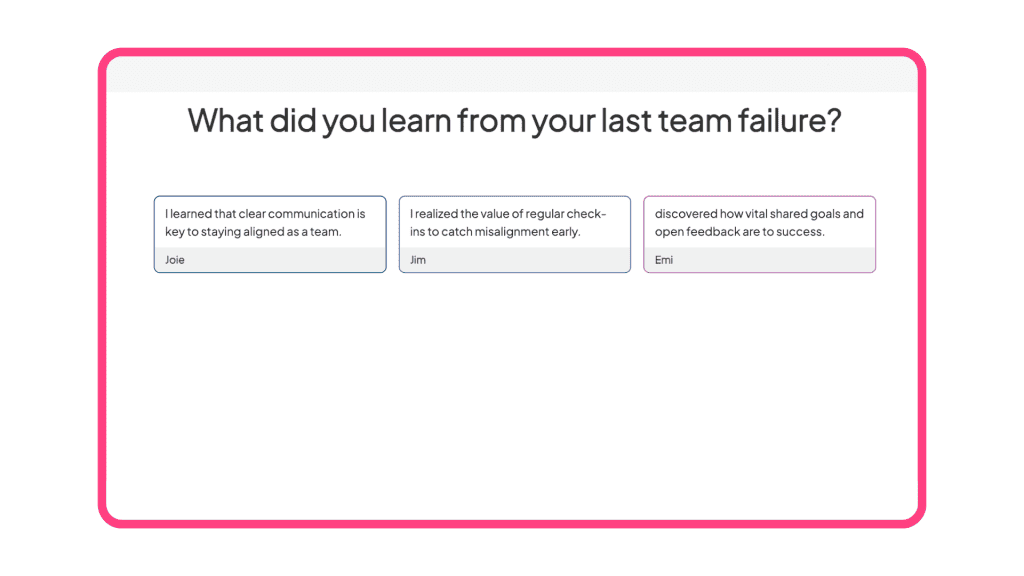
The Science Behind Effective Icebreakers
Understanding why certain icebreaker approaches work helps trainers select and adapt activities more strategically.
Social cognitive neuroscience research shows that activities requiring us to think about others' mental states and characteristics activate brain regions associated with empathy and social understanding. "Most likely to" questions explicitly require this mental exercise, strengthening team members' ability to perspective-take and empathise.
Research on psychological safety from Harvard Business School professor Amy Edmondson demonstrates that teams where members feel safe to take interpersonal risks perform better on complex tasks. Activities that involve mild vulnerability (like being playfully identified as "most likely to trip over their own feet") create opportunities to practice giving and receiving gentle teasing, building resilience and trust.
Studies on shared experiences and group cohesion show that teams that laugh together develop stronger bonds and more positive group norms. The unexpected moments and genuine amusement generated during "most likely to" activities create these bonding experiences.
Engagement research consistently finds that activities requiring active participation and decision-making maintain attention better than passive listening. The cognitive effort of evaluating colleagues against specific scenarios keeps brains engaged rather than wandering.
Small Activities, Significant Impact
"Most likely to" questions might seem like a small, even trivial component of your training or team development programme. However, the research is clear: activities that build psychological safety, surface personal information, and create shared positive experiences have measurable impacts on team performance, communication quality, and collaboration effectiveness.
For trainers and facilitators, the key is approaching these activities as genuine team development interventions, not just time-fillers. Select questions thoughtfully, facilitate professionally, debrief thoroughly, and connect insights to your broader team development goals.
When executed well, spending 15 minutes on "most likely to" questions can yield weeks or months of improved team dynamics. Teams that know each other as complete people rather than just job titles communicate more openly, collaborate more effectively, and navigate conflict more constructively.
The questions in this guide provide a foundation, but the real magic happens when you adapt them to your specific context, facilitate with intentionality, and leverage the insights they generate to strengthen your team's working relationships. Combine thoughtful question selection with interactive engagement technology like AhaSlides, and you've transformed a simple icebreaker into a powerful team-building catalyst.
References:
Decety, J., & Jackson, P. L. (2004). The functional architecture of human empathy. Behavioral and Cognitive Neuroscience Reviews, 3(2), 71-100. https://doi.org/10.1177/1534582304267187
Decety, J., & Sommerville, J. A. (2003). Shared representations between self and others: A social cognitive neuroscience view. Trends in Cognitive Sciences, 7(12), 527-533.
Dunbar, R. I. M. (2022). Laughter and its role in the evolution of human social bonding. Philosophical Transactions of the Royal Society B: Biological Sciences, 377(1863), 20210176. https://doi.org/10.1098/rstb.2021.0176
Edmondson, A. C. (1999). Psychological safety and learning behavior in work teams. Administrative Science Quarterly, 44(2), 350-383. https://doi.org/10.2307/2666999
Kurtz, L. E., & Algoe, S. B. (2015). Putting laughter in context: Shared laughter as behavioral indicator of relationship well-being. Personal Relationships, 22(4), 573-590. https://doi.org/10.1111/pere.12095
